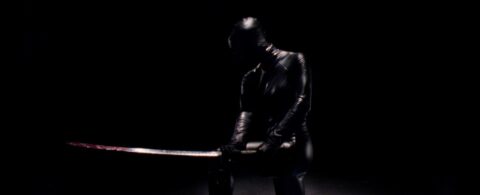Reflection in a Dead Diamond (Hélène Cattet, Bruno Forzani, 2025) is easily the most stylish and formally exciting film playing in the Berlinale competition so far; a riot of visuals, moods, aesthetics and pastiches that pushes and pulls cinematic language with absolute joy and ease. A deeply European and moody take on 60s and 70s spy clichés with a touch of Giallo and a splash of Godard, its depiction of the eternal cyclical struggle between a special agent and a mysterious assassin is a loving, entertaining homage to graphic novels, Charade (Stanley Donen, 1963) and OSS 117 that is a little hard to follow but certainly easy to love.
Set on the gorgeous Cote D’Azur, where France seems to melt into Italy with a touch of Monegasque luxury — big hotels, bigger casinos, the extraordinary deep blue Mediterranean, rugged coastal paths, classic cars — Reflection stars legendary Italian actor Fabio Testi as John D., a retired spy enjoying a drink by the sea while staring at a woman in a bikini. Very much playing with its supercharged male gaze, like James Bond after far too many Martinis, we watch as she takes off her bra, revealing her nipple to be pierced with a sparkling diamond. I mean, they are a girl’s best friend after all…
This is the first clue that Reflection is not going to be a traditional spy thriller, but a rather silly yet satisfying reverie on the machinations and schemes of the genre itself. In this directing duo’s madcap vision, when sex, beautiful women and diamonds are near, death is almost right around the corner. Soon John D is awash in a confusing trip down memory lane, remembering his endless fights with the mysterious assassin Serpentik (Thi Mai Nguyen), who is as beautiful as she is lethal, dispatching men with a whole variety of ridiculous kung-fu tricks1Dolemite would love this movie. The film constantly cuts between Testi and Yannick Renier playing his younger self, collapsing the past and present in an endless montage of supercharged espionage hijinks.
This is cinematic madness in its purest form. Whether it’s inserts, Leone-esque close-ups, use of rear projection, crash zooms, whip pans, cartoon cutaways, cross-cutting, or match cuts, Cattet and Forzani use every tool at their disposal. The stories are constantly enveloped within each other in this metafictional ouroboros, showing how the reality and the legend can feel so close that it’s hard to say where one starts and the other ends.
It can lean into the gore quite significantly, especially with many dismembered body parts. And the film is constantly taking women’s clothes off — including the totally captivating Céline Camara as a fellow woman spy alongside various others — yet there is nothing leering or mean-spirited here. The women are seen as equally strong and powerful — and ambitious — as the men, with John D and Serpentik true equals in their eternal struggle. It’s like watching Batman v Joker, or Spider-Man v the Green Goblin; nemeses going at it again and again and again, with muddled continuity and retconned results. At a time when comic book movies lean more and more into CGI sludge, here’s a take on graphic novel aesthetics that, although deeply steeped in the mid-20th century, feels like an innovation of the genre (among many others!). I truly loved this movie.

Redmond is the editor-in-chief of Journey Into Cinema.
